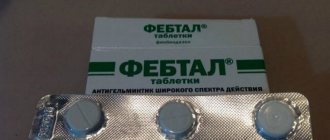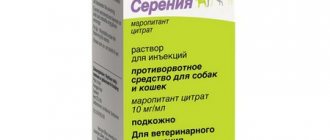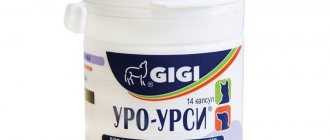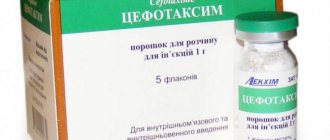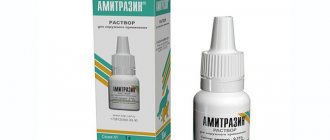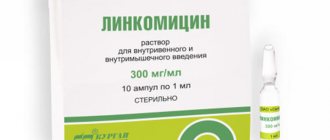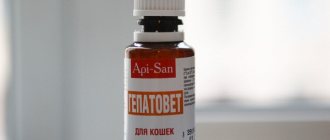Composition and action
Flexoprofen contains ketoprofen as its main component. It prevents the production of substances in the cat’s body that contribute to inflammation, pain, and swelling. With subcutaneous administration of the drug, the maximum concentration of ketoprofen in the blood plasma is achieved in 15-20 minutes, with intramuscular administration - even faster.
The drug contains the amino acid L-arginine. It is necessary for the production of ornithine, a substance that binds ammonia. Accumulating in the blood, ammonia can cause intoxication of the entire body, which will lead to the death of the pet. L-arginine is involved in protein synthesis, strengthens the immune system and stimulates the production of insulin in the pet’s body.
The action of Flexoprofen is multifaceted:
- the drug effectively relieves inflammatory processes in joints, organs and tissues;
- eliminates pain and spasms of smooth muscles;
- removes swelling and redness;
- lowers temperature and relieves fever.
The advantages of Flexoprofen over other drugs of the same group are its high speed of action and bioavailability (85-100%) of the active component. The drug is well absorbed and begins to work intensively half an hour after intramuscular administration. It moves through the bloodstream throughout the body, quickly relieves pain and reduces temperature. Flexoprofen is active for up to 20 hours, after which it leaves the cat’s body naturally through the kidneys and genitourinary system. The drug is low-hazard.
How does Flexoprofen work?
Prostaglandins play an important role in the development of the inflammatory process, the occurrence of fever and pain. These are hormone-like substances synthesized by almost all tissues of the body and affecting the contraction of smooth muscles. Suppression of prostaglandin synthesis is the main task of ketoprofen, which is part of Flexoprofen.
Relief of pain and decrease in body temperature occurs after one dose of the drug (symptoms subside approximately 5 minutes after the injection, after 30 minutes the maximum concentration of the active substance in the plasma is reached). The therapeutic effect lasts 18–20 hours, then the substance is excreted by the kidneys. For a persistent anti-inflammatory effect, a course of medication is required (inject daily for 2–5 days, the duration of the course is determined by the veterinarian based on the diagnosis and general condition of the animal).
Purpose
Veterinarians prescribe Flexoprofen for cats with the following pathologies of the musculoskeletal system:
- osteoarthritis;
- spondyloarthrosis;
- rheumatoid and gouty arthritis;
- dislocations;
- bruises;
- fractures;
- herniated intervertebral discs;
- extra-articular rheumatism (capsulitis, bursitis);
- synovitis;
- tenosynovitis;
- traumatic pain.
In addition, the medicine is used for acute attacks of colic, elevated body temperature, and in postoperative therapy to reduce tissue swelling and eliminate pain syndromes. Flexoprofen is used in complex treatment to relieve symptoms of the disease (fever, swelling, pain), but it does not treat the causes themselves.
Indications for use
Preparations containing ketoprofen are prescribed for the treatment of inflammatory and degenerative diseases of the musculoskeletal system, including:
- rheumatoid arthritis;
- spondyloarthrosis;
- gouty arthritis;
- intervertebral hernia;
- osteoarthritis;
- extra-articular rheumatism (bursitis, capsulitis).
The drug provides symptomatic relief. For example, it has a pronounced antipyretic property and is prescribed to relieve pain of any origin, including in the postoperative period and after an animal has been injured.
Flexoprofen can be given to cats after surgery and to reduce post-traumatic pain
Dosage
Flexoprofen can be administered to a cat intravenously, intramuscularly or subcutaneously. Typically, intravenous injections are made in a veterinary clinic at a high temperature, this allows you to quickly relieve the symptom, since the drug begins to act much faster than with other types of drug administration. At home, Flexoprofen is injected subcutaneously into the withers or intramuscularly into the thigh at an angle of 90 degrees.
The duration of treatment is prescribed by the veterinarian, taking into account the diagnosis and condition of the cat, and he also determines the dosage of the drug. Before prescribing the dose, it is necessary to weigh the cat, since the amount of solution administered depends on the weight of the animal.
The dose is calculated based on the cat's weight. If the pet weighs 5 kg, then the active substance per injection requires 10 mg, or 0.2 ml of Flexoprofen solution. The drug is administered once a day. Treatment lasts from 1 to 5 days. Continued use of the drug may cause side effects, as well as an incorrectly calculated dosage. It is not recommended to interrupt the course of treatment, as this will reduce the effectiveness of therapy.
Main characteristics of Flexoprofen
Flexoprofen is available only in the form of a clear or light yellow solution. Packaged in dark glass containers of 10, 50, 100 ml. 1 ml of the drug can contain 25 mg, 50 mg and 100 mg of the active substance (ketoprofen). The additional components included are:
- water;
- phenylcarbinol;
- lemon acid.
The shelf life of Flexoprofen is 36 months from the date of manufacture. The drug is kept in a closed bottle in a dry place at a temperature of 5 to 25 °C. During storage, precipitation in the form of small white crystals is allowed. This is not a sign of loss of properties of the medicine - you just need to shake the bottle well before use to dissolve the crystals.
It is better to buy Flexoprofen for cats in 10 ml bottles with a dosage of 2.5%
Limitations and side effects
With a correctly calculated dosage of the drug and use for no more than 5 days, no complications or side effects were identified.
If the dose of Flexoprofen is exceeded, negative symptoms may occur:
- vomit;
- stomach upset;
- refusal of food.
In this case, it is necessary to immediately stop taking the medication and take the cat to the veterinarian for symptomatic help.
Flexoprofen, although it belongs to the class of low-hazard substances, can still cause adverse reactions in the body:
- drowsiness;
- dizziness;
- burping;
- nausea;
- increased gas formation;
- constant desire to drink;
- diarrhea;
- weakness;
- tachycardia.
Mild manifestations of side effects are acceptable, and treatment is not interrupted; in case of pronounced symptoms, consultation with a veterinarian is necessary.
Flexoprofen for cats is contraindicated in the following cases:
- if the animal has hypersensitivity to the components;
- in case of blood clotting disorders, hemorrhagic syndrome;
- for pathological diseases of the liver and kidneys;
- in case of progressive or chronic diseases of the gastrointestinal tract - gastric and duodenal ulcers;
- during periods of pregnancy and feeding of kittens.
The medicine should not be administered simultaneously with other solutions, including vitamins, or mixed in a syringe to avoid the formation of toxic compounds. In Flexoprofen therapy, other drugs from the same group of anti-inflammatory drugs should not be used together.
The use of Flexoprofen is not recommended:
- before mating – the drug reduces the permeability of the egg;
- lactating cats - 5% of the drug passes into mother's milk.
Flexoprofen can be used in the treatment of newborn kittens from the first day, but the dose must be carefully calculated by the veterinarian.
The drug is often used in combination with Ranitidine or other similar medications, since the active substance ketoprofen can cause bleeding in the cat's digestive system.
Contraindications and precautions
Despite the effectiveness of the drug, it is not recommended to use it if the pet has some problems in the body: Presence of ulcers. Poor blood clotting. Diseases of the filtering organs (kidneys/liver). Allergy to the components of the drug.
Reference! During the period of gestation (throughout the entire period), restrictions on the use of the medicine apply.
If after administration of the injection symptoms characteristic of an allergy are observed, you should stop using Flexoprofen. To continue treatment, you must contact your veterinarian to select a more suitable anti-inflammatory drug. When carrying out treatment procedures, it is recommended to take into account the following safety measures. Do not allow the solution to come into contact with the mucous membrane (if necessary, rinse the affected area with plenty of running water). The drug is used only certified with the appropriate expiration date. You should wash your hands before administering the injection. Treat the cat's skin with an antiseptic. While performing manipulations, you must not eat, drink, or smoke. The used syringe and medication bottle should be discarded.
Analogs
Flexoprofen is an effective anti-inflammatory agent. If it is not possible to purchase it, or the animal has an allergic reaction to its constituent components, then you should choose another drug.
Analogues of Flexoprofen are:
- Ainil;
- Onsior;
- Loxicom;
- Ketoquin.
Ainil
The active ingredient of the drug is ketoprofen. Available in the form of injection solution 1 and 10%. The composition is completely identical to Flexoprofen. One percent is good for treating small kittens.
Onsior
The active substance is robenacoxib. Available in tablets of 5, 6, 10, 20 mg. Difficulties arise due to the release form, since it is more problematic to calculate the exact dosage. If the cat weighs less than 2.5 kg, then the drug should not be given to it.
Loxicom
The active ingredient is meloxicam. It is a suspension for internal administration at 0.05, 0.15%. Unlike Flexoprofen, the effect does not occur immediately; the maximum concentration in the body is reached after 4–6 hours.
Ketoquin
The active ingredient is ketoprofen. Contains L-arginine. Available in the form of an injection solution of 1 and 10%. The first one is suitable for small kittens.
Any substitutes for Flexoprofen have their own contraindications and nuances of use. Therefore, the treatment regimen for your pet must be agreed upon with your veterinarian.
Flexoprofen is an effective remedy that has its own characteristics in use. It should be used only after a doctor's prescription and reading the instructions. In recommended doses it does not cause side effects.
Contraindications, use of other drugs
Contraindications to the administration of Flexoprofen are as follows:
- Individual intolerance to both ketoprofen itself and its excipients.
- Hemorrhagic syndrome.
- Pregnancy.
- Both renal and liver failure.
- Ulcer of the duodenum, stomach.
It is not recommended to mix it with other dosage forms in the same syringe. It is also prohibited to combine with the following medications:
- Diuretics.
- Non-steroidal anti-inflammatory drugs.
- Anticoagulants.
- Glucocorticosteroids.
Consumer Reviews
Opinions about the use of the medicine confirm its effectiveness.
My puppy sprained his hind leg near the hip joint, the veterinarian prescribed Flexoprofen for two days at a dosage of 3 mg per day, two weeks after treatment the lameness completely disappeared, now we don’t even remember about the disease.
Alina
They picked up a lame cat on the street, when I tried to examine her, I resisted, and since the veterinary clinic had the weekend, the neighbors gave me the packaged Flexoprofen. She chose the dosage herself and injected the drug for two days; until Monday the cat did not react so sharply to touch, and the doctor then approved and prescribed comprehensive treatment for arthritis.
Olga
I work as a veterinarian, and in my practice there have been cases of stomach upset while taking Flexoprofen, so I think the most important thing is to avoid an overdose of the drug, but in general the product is good and helps relieve the animal of pain in a short time.
Igor
Last year my cat developed joint problems. The veterinarian I consulted diagnosed Jessie with arthritis and recommended Flexoprofen injections. After 4 injections, my pet began to feel better. I was very pleased with the results of the treatment. I recommend this product to all cat owners who are faced with a similar problem.
Ekaterina Valentinovna, Vladivostok
I used this drug as an anesthetic for a cat in the postoperative period. I believe that this is one of the few remedies that really work. My rating for the drug is 5 out of 5!
Victor, Moscow
An effective and inexpensive anti-inflammatory agent. I used it the year before last to treat arthrosis in a cat. After the injections, my pet became cheerful and active, there were no side effects. I recommend!
Sergey, St. Petersburg
Flexoprofen is a non-steroidal anti-inflammatory and antipyretic medicine that is used for cats for chronic and acute joint diseases, as well as for injuries and after operations. The drug effectively relieves pain and inflammation, but it should not be used without a veterinarian's prescription due to a number of contraindications and possible side effects.
How it works
Flexoprofen has the following properties:
- eliminates pain;
- relieves inflammation;
- reduces swelling;
- has an antipyretic effect.
The effect of the drug is determined by ketoprofen. The principle of its action is that when it enters the body, the active component blocks the production of substances that are involved in inflammatory processes, accompanied by pain, swelling, and redness.
The advantage of Flexoprofen is its rapid action. Just 30 minutes after injection, the concentration of ketoprofen in the blood reaches its maximum value.
The components of the drug are excreted from the body mostly through the kidneys.
The drug is effectively used in the treatment of chronic and acute pathologies. Indications for the use of Flexoprofen for cats according to the instructions are:
- arthritis, arthrosis and other diseases of the musculoskeletal system;
- fractures, dislocations and other injuries;
- acute colic;
- pathologies that are accompanied by an increase in body temperature.
We suggest you read: Subcutaneous bumps in cats
Also, the medicine is often prescribed in the postoperative period to reduce pain and prevent swelling.
Note! The medicine is used to eliminate unpleasant symptoms (pain, swelling, increased body temperature), but it is not able to cope with the cause of the disease, so it is used only in complex therapy.
How to use
Typically, Flexoprofen is administered to cats intramuscularly or subcutaneously. For acute pain or extreme fever, it is recommended to give intravenous injections so that the medicine begins to work faster.
The dose is calculated based on the pet's weight, so you need to weigh it first. For every kilogram of weight you need 2 mg of the active substance. The amount of solution depends on its concentration.
Typically 2.5% Flexoprofen is used for cats. 1 ml of this solution contains 25 mg of ketoprofen, that is, it is designed for 12.5 kg.
To avoid overdose, entrust the calculation of the dose for your cat to your veterinarian.
Injections should be given once a day. The course of treatment can last from 1 to 5 days. It is not recommended to use the medicine for more than 5 days due to the risk of side effects.
You should avoid missing the next injection, as this may affect the effectiveness of the drug. If the injection could not be given on time for some reason, you need to return to treatment as soon as possible.
There is no need to increase the dose.
Important points
When using Flexoprofen to treat cats, the following should be considered:
- The anesthetic should not be combined with the use of other non-steroidal anti-inflammatory drugs to avoid overdose.
- It is not recommended to use the medicine together with anticoagulants (drugs that thin the blood), glucocorticoids and laxatives.
- Do not mix an anti-inflammatory drug with other medications in the same syringe.
- When administering a medicinal solution, you must follow the rules of antiseptics. For injections, use disposable syringes or sterile needles that have been boiled for 15 minutes.
Flexoprofen can have a negative effect on the digestive system and cause bleeding, so its use is often combined with Ranitidine or other similar medications.
When working with the drug, you need to follow simple safety precautions. After the procedure, wash your hands with soap and running water.
If you are hypersensitive, you should use rubber or latex gloves to avoid direct contact with the solution, which can cause a rash or other allergic reactions.
According to the instructions, Flexoprofen for cats cannot be used in the following cases:
- when bearing offspring (regardless of the period);
- with liver failure;
- with renal failure;
- for problems with blood clotting;
- with bleeding;
- with stomach or duodenal ulcers.
You should also avoid using the drug if you are intolerant to the active substance or other components. For chronic pathologies of the liver and kidneys, it is necessary to consult a doctor before use. In this case, it is recommended to constantly monitor the performance of these organs.
The anesthetic is usually well tolerated by animals and does not cause side effects. In case of intolerance to the components, allergic reactions occur. In this case, further treatment with an anti-inflammatory drug is stopped and anti-allergy medications and drugs are prescribed to relieve the symptoms that appear.
In case of overdose, the following side effects may occur:
- nausea;
- vomit;
- stomach upset;
- loss of appetite;
- refusal of food;
- weakness.
If such symptoms appear, stop taking Flexoprofen. If the animal's condition does not improve, you should consult a doctor.
Price
For cats, it makes sense to buy only 10 ml bottles with a 2.5% solution. The price of such a bottle of Flexoprofen ranges from 270 to 300 rubles, depending on the region and pharmacy. The drug is sold in all veterinary pharmacies and many pet stores. You can also order it online, so there will be no problems with the purchase.
Owner reviews
“When our cat caught the infection (she had feline distemper), she developed a very high temperature. To relieve fever, the doctor prescribed Flexoprofen. One injection was enough for the temperature to return to normal and not rise again. There were no side effects, Muska tolerated the medicine well.”
“Older animals often have joint problems. They didn't spare our 10-year-old cat either. Arthritis was accompanied by severe pain. The joints were swollen. The cat refused to even walk around the house.
On the advice of a doctor, Flexoprofen injections were used to eliminate these symptoms. A week later, the cat began to run again, and the pain stopped bothering him.
It’s a good medicine, but after a while the symptoms return, so we repeat the course every 2-3 months.”
“When we treated our cat for uveitis, Flexoprofen was also included in the complex therapy. The drug saved the animal from suffering. Even after stopping treatment, the pain did not return. It’s a good drug, but you shouldn’t use it for self-medication because of the risk of aggravating health problems.”
Reviews from veterinarians
“A good anti-inflammatory and analgesic agent, which has a relatively mild effect compared to analogues.
Repeatedly prescribed it for severe pain to quickly eliminate it. Sometimes I use it after operations.
Just one or two injections help make it easier for your pet to undergo surgery and prevent complications in the form of inflammation and swelling.”
“I have been using Flexoprofen in my practice for a long time, as I believe that it has a good price-quality ratio. This is one of the few domestic medicines that inspires trust. In my practice there were no side effects. Usually cats and kittens tolerate injections well if the dose is calculated correctly.”
Personal precautions when working with medicine
When working with the drug, you must follow the usual safety precautions:
- Avoid getting the solution into your eyes. In this case, the eye should be immediately rinsed with water.
- If the medicine gets on your hands, you should immediately wash it off and wash your hands with soap.
- The bottles are stored far from children, and storage conditions are normal - temperature in the range of +5 +25 ° C, humidity within 75%.
- It is not recommended to store in open areas, as it is better to avoid direct sunlight.
The medicine is valid for 36 months from the date of manufacture, after which it cannot be used. The bottles are disposed of as normal household waste. It is not allowed to store any objects, water, and especially food in used bottles.
